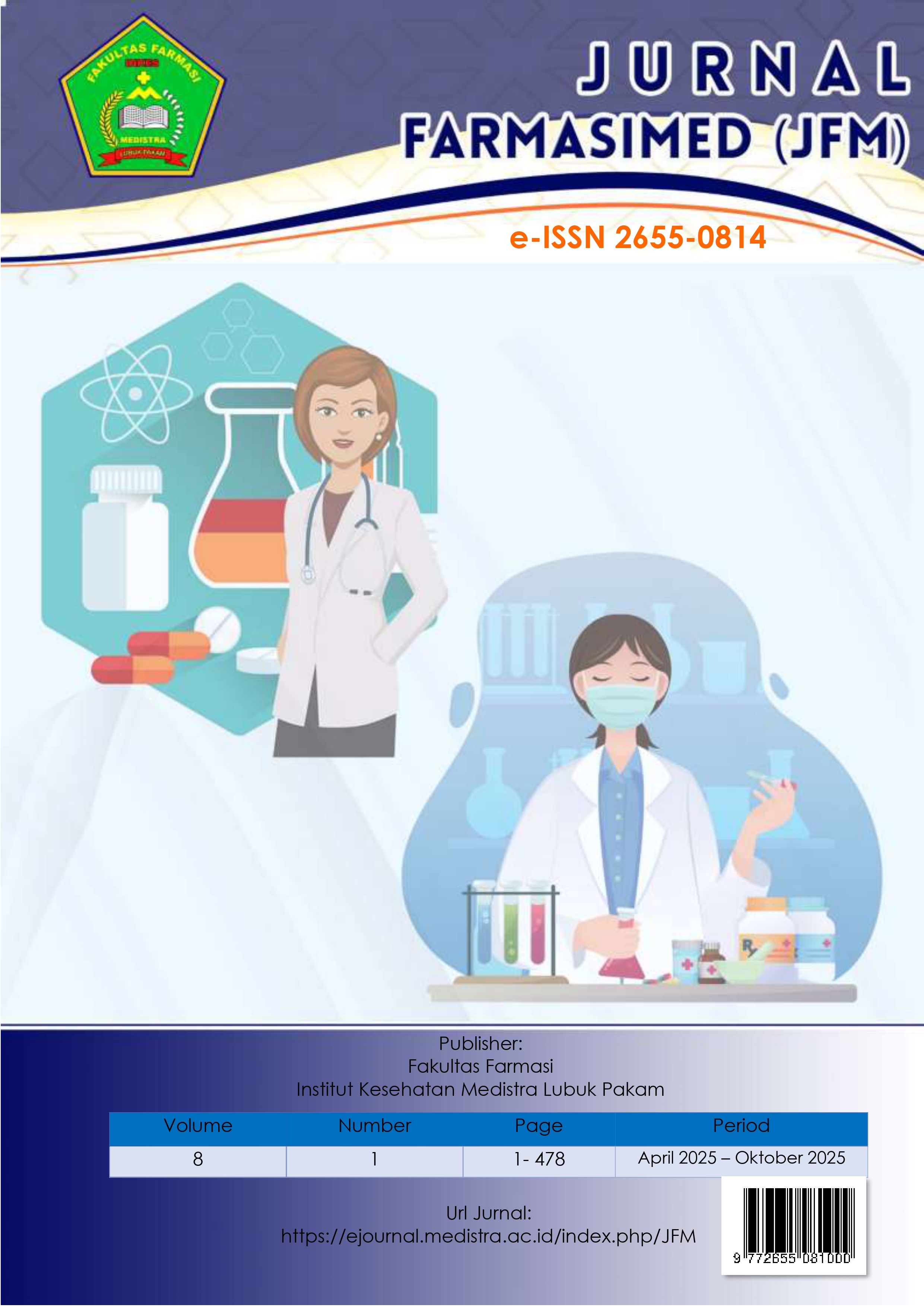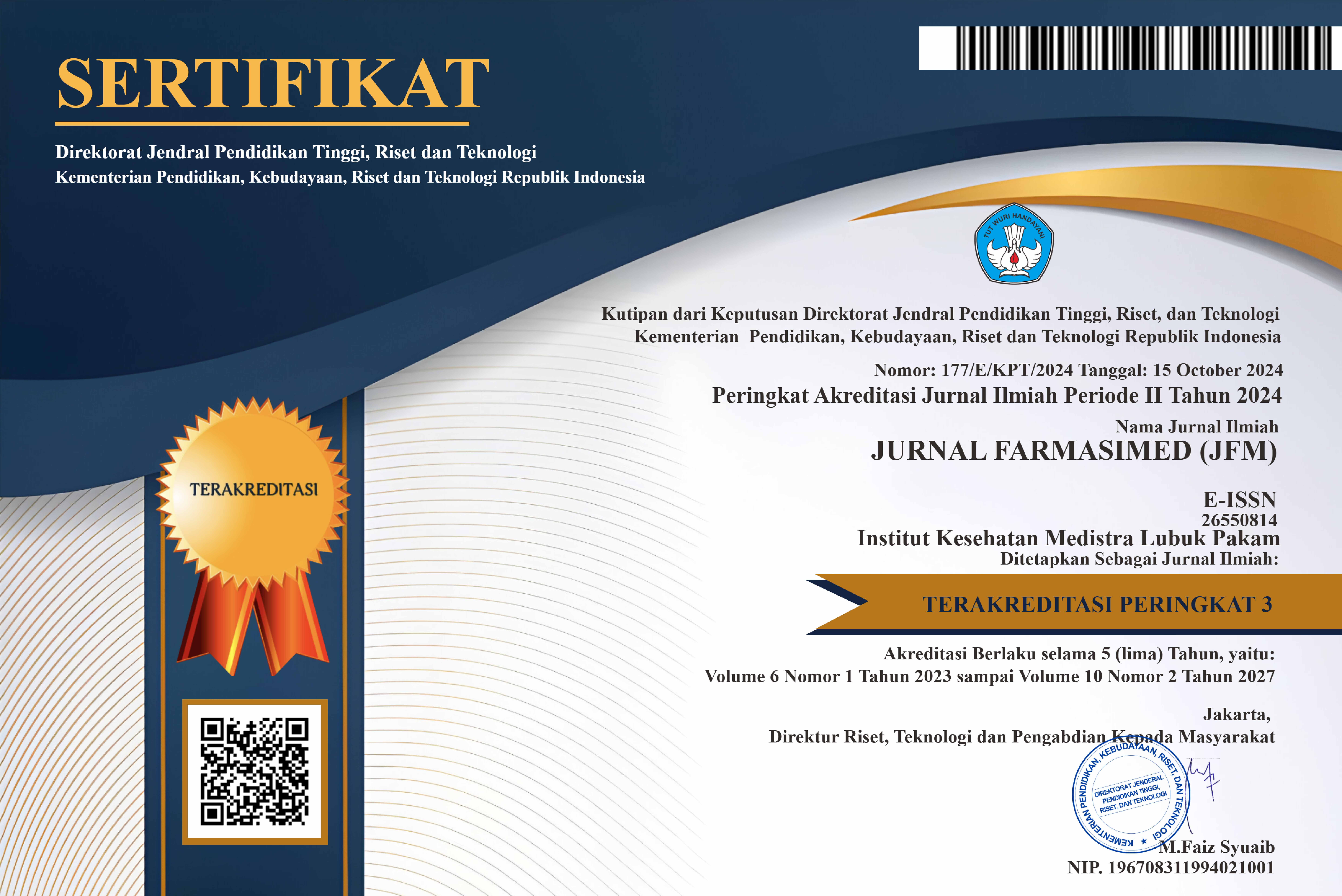Optimization of Water-Ethanol Solvent Composition of Red Betel Leaf Extraction (Piper crocatum Ruiz & Pav) Using Simplex Latice Design Method on Antioxidant Activity
DOI:
https://doi.org/10.35451/5d1c7339Keywords:
Ultrasound-assisted extraction, TPC, Red Betel, Free radicals, ABTSAbstract
Background: Free radicals cause oxidative stress that contributes to degenerative diseases and premature aging. Red betel leaves (Piper crocatum Ruiz & Pav) contain phenolic and flavonoid compounds with high antioxidant potential. Objective: This study aimed to determine the optimal water-ethanol solvent composition for red betel leaf extraction based on total phenol content and antioxidant activity. Method: Red betel leaf extraction was carried out by ultrasonication using several ratios of water and 96% ethanol solvents, then optimized using Simplex Lattice Design. Antioxidant activity was evaluated using the 2,2-azinobis(3-ethyl-benzothiazoline-6 sulfonic acid (ABTS) method, which was measured using a microplate reader. Total phenol content was determined using a spectrophotometric method. Results: Red betel leaves extracted with water-ethanol solvent (0:100) showed the highest total phenol content of 152.23 ± 0.2 mg GAE/g with an IC50 of 74.18 ppm, which is categorized as strong. ANOVA analysis showed a significant model (p < 0.05) with R² > 0.90, confirming a strong correlation between phenolic content and antioxidant activity. SLD optimization produced a desirability value close to 1.0, indicating that ethanol is the most optimal solvent. Conclusion: Red betel leaves have strong potential as a source of natural antioxidants with ethanol as the optimal solvent for the extraction of bioactive compounds.
Downloads
References
[1] D. E. Jewell, L. A. Motsinger, and I. Paetau-Robinson, “Effect of dietary antioxidants on free radical damage in dogs and cats,” J Anim Sci, vol. 102, Jan. 2024, doi: 10.1093/jas/skae153.
[2] P. Chaudhary et al., “Oxidative stress, free radicals and antioxidants: potential crosstalk in the pathophysiology of human diseases,” 2023, Frontiers Media S.A. doi: 10.3389/fchem.2023.1158198.
[3] F. Ebrahimirad et al., “Antioxidant strategies against cellular senescence: unveiling the power of synthetic versus natural antioxidants in a systematic review,” 2025, Frontiers Media SA. doi: 10.3389/fragi.2025.1543360.
[4] U. Chae, J.-W. Park, S.-R. Lee, H. J. Lee, H.-S. Lee, and D.-S. Lee, “Reactive oxygen species-mediated senescence is accelerated by inhibiting Cdk2 in Idh2-deficient conditions,” Aging, vol. 11, no. 17, pp. 7242–7256, Sep. 2019, doi: 10.18632/aging.102259.
[5] L. Deng et al., “The Role of Oxidative Stress and Antioxidants in Diabetic Wound Healing,” Oxid Med Cell Longev, vol. 2021, no. 1, Jan. 2021, doi: 10.1155/2021/8852759.
[6] C. Jiratchayamaethasakul et al., “In vitro screening of elastase, collagenase, hyaluronidase, and tyrosinase inhibitory and antioxidant activities of 22 halophyte plant extracts for novel cosmeceuticals,” Fish Aquatic Sci, vol. 23, no. 1, Mar. 2020, doi: 10.1186/s41240-020-00149-8.
[7] H. Wahyudi, Adlim, and M. Nasir, “Uji Aktivitas Antioksidan Ekstrak Buah Srikaya (Annona Squamosa L.) Muda dan Matang dengan Metode FRAP (Ferric Reducing Antioxidant Power),” Al-Kimia, vol. 10, no. 1, Jun. 2022, doi: 10.24252/al-kimia.v10i1.27391.
[8] S. G. Tumilaar, A. Hardianto, H. Dohi, and D. Kurnia, “A Comprehensive Review of Free Radicals, Oxidative Stress, and Antioxidants: Overview, Clinical Applications, Global Perspectives, Future Directions, and Mechanisms of Antioxidant Activity of Flavonoid Compounds,” J Chem, vol. 2024, pp. 1–21, May 2024, doi: 10.1155/2024/5594386.
[9] R. Oktavia, R. Saputri, P. S. Studi, and F. Kesehatan, “Aktivitas Antioksidan Dan Penetapan Kadar Flavonoid Daun Sirih Merah (Piper Crocatum Ruiz & Pav) Dengan Variasi Ukuran Partikel Serbuk Simplisia,” Journal of Pharmaceutical Care and Sciences, vol. 4, p. 25, 2023, doi: 10.33859/jpcs.
[10] S. A. Prayitno, J. K. Kusnadi, and E. S. Murtini, “Karakteristik (Total Flavonoid, Total Fenol, Aktivitas Antioksidan) Ekstrak Serbuk Daun Sirih Merah (Piper crocatum Ruiz & Pav.),” FOODSCITECH, vol. 1, no. 2, p. 26, Dec. 2018, doi: 10.25139/fst.v1i2.1355.
[11] D. A. Maya-Cano, S. Arango-Varela, and G. A. Santa-Gonzalez, “Phenolic compounds of blueberries (Vaccinium spp) as a protective strategy against skin cell damage induced by ROS: A review of antioxidant potential and antiproliferative capacity,” Heliyon, vol. 7, no. 2, p. e06297, Feb. 2021, doi: 10.1016/j.heliyon.2021.e06297.
[12] B. Aguiar, H. Carmo, J. Garrido, J. M. Sousa Lobo, and I. F. Almeida, “In Vitro Evaluation of the Photoreactivity and Phototoxicity of Natural Polyphenol Antioxidants,” Molecules, vol. 27, no. 1, p. 189, Dec. 2021, doi: 10.3390/molecules27010189.
[13] M. A. Johari and H. Y. Khong, “Total Phenolic Content and Antioxidant and Antibacterial Activities of Pereskia bleo,” Adv Pharmacol Sci, vol. 2019, pp. 1–4, Jan. 2019, doi: 10.1155/2019/7428593.
[14] I. Susana, A. Ridhay, and S. Bahri, “Kajian Aktivitas Antioksidan Ekstrak Batang Kecombrang (Etlingera Elatior) Berdasarkan Tingkat Kepolaran Pelarut,” Kovalen: Jurnal Riset Kimia, vol. 4, no. 1, pp. 16–23, May 2018, doi: 10.22487/kovalen.2018.v4.i1.10178.
[15] W. Hajrin, W. A. Subaidah, Y. Juliantoni, and D. G. Wirasisya, “Application of Simplex Lattice Design Method on The Optimisation of Deodorant Roll-on Formula of Ashitaba (Angelica keiskei),” Jurnal Biologi Tropis, vol. 21, no. 2, pp. 501–509, Jul. 2021, doi: 10.29303/jbt.v21i2.2717.
[16] N. U. M. Br. Turnip, Ratih Anggraeni, Y. R. Sihombing, and Suci Wulandari, “Test to Determine The Quercetin Content of Tenggiang (Polystichum setiferum) Using the High Performance Liquid Chromatography (HPLC) Method and Its Antifungal Activity Against Pityrosporum ovale,” JURNAL FARMASIMED (JFM), vol. 7, no. 2, pp. 135–142, Apr. 2025, doi: 10.35451/jfm.v7i2.2361.
[17] I. K. Kartika, I. Fataya, M. Yunus, and N. D. Yuliana, “Optimasi Proses Ekstraksi Minyak Dan Resin Nyampung Dengan Pelarut Binermenggunakan Response Surface Method,” Jurnal Teknologi Industri Pertanian, pp. 21–31, 2022, doi: 10.24961/j.tek.ind.pert.2022.32.1.21.
[18] Ika Julianti Tambunan and Siti Muliani, “Formulation and Antioxidant Activity Test Of Body Lotion Preparation of Ethanol Extract of Sky Mustard Leaves (Cyanthillium cinereum (L) H.Rob) As A Moisturizer,” JURNAL FARMASIMED (JFM), vol. 7, no. 2, pp. 187–194, Apr. 2025, doi: 10.35451/jfm.v7i2.2441.
[19] S. A. Prayitno, J. Kusnadi, and E. S. Murtini, “Karakteristik (Total Flavonoid, Total Fenol, Aktivitas Antioksidan) Ekstrak Serbuk Daun Sirih Merah (Piper crocatum Ruiz & Pav.),” Piper crocatum Ruiz & Pav, 2018.
[20] I. N. E. Lister et al., “Antioxidant properties of red betel (Piper crocatum) leaf extract and its compounds,” Journal of Natural Remedies, vol. 19, no. 4, pp. 198–205, Oct. 2019, doi: 10.18311/jnr/2019/23633.
[21] K. Kurniawan, A. T. Pertiwi, and I. T. Lestari, “Analisa Absorbansi Kadar Flavonoid Total Ekstrak Maserasi Daun Sirih Hijau (Piper betle L.),” Pharmaceutical Journal of Islamic Pharmacy, vol. 5, no. 1, p. 80, Mar. 2021, doi: 10.21111/pharmasipha.v5i1.5707.
[22] K. Anwar, F. M. Lokana, and A. Budiarti, “Antioxidant Activity of Dewandaru Leaf (Eugenia Uniflora L.) Ethanol Extract and Determination of Total Flavonoid and Phenolic Content,” Jurnal Ilmiah Sains, pp. 161–171, Oct. 2022, doi: 10.35799/jis.v22i2.43913.
[23] M. Spiegel et al., “Antioxidant Activity of Selected Phenolic Acids–Ferric Reducing Antioxidant Power Assay and QSAR Analysis of the Structural Features,” Molecules, vol. 25, no. 13, p. 3088, Jul. 2020, doi: 10.3390/molecules25133088.
[24] B. Guo et al., “Electron structure variations in hindered phenolic antioxidant induced enhancement of thermo-oxidative aging performance in polyamide 6,” RSC Adv, vol. 15, no. 19, pp. 14594–14603, 2025, doi: 10.1039/D5RA01209K.
[25] I. L. Dominguez, M. Pérez, and R. M. Lamuela-Raventós, “Total (poly)phenol analysis by the Folin-Ciocalteu assay as an anti-inflammatory biomarker in biological samples,” Crit Rev Food Sci Nutr, vol. 64, no. 27, pp. 10048–10054, Oct. 2024, doi: 10.1080/10408398.2023.2220031.
[26] I. L. Lawag, E. S. Nolden, A. A. M. Schaper, L. Y. Lim, and C. Locher, “A Modified Folin-Ciocalteu Assay for the Determination of Total Phenolics Content in Honey,” Applied Sciences, vol. 13, no. 4, p. 2135, Feb. 2023, doi: 10.3390/app13042135.
[27] A. Agustin et al., “Penetapan Kadar Fenol Total Ekstrak Etanol Berbagai Biji Buah Salak Bali (Salacca zalanca var. ambonensis) Menggunakan Metode Folin Ciocalteu Total Phenolic Content Determination of Ethanolic Extract from Various Salak Bali Seeds (Salacca zalanca var. ambonensis) Using the Folin Ciocalteu Method,” 2022.
[28] A. Ulfa et al., “Potensi Ekstrak Kulit Pisang Kepok (Musa paradisiaca forma typica) dan Uli (Musa paradisiaca sapientum) Menaikkan Aktivitas Superoksida Dismutase dan Menurunkan Kadar Malondialdehid Organ Hati Tikus Model Hiperkolesterolemia,” Acta Vet Indones, vol. 8, no. 1, pp. 40–46, 2020, [Online]. Available: http://www.journal.ipb.ac.id/indeks.php/actavetindones
[29] B. Bekdeşer and R. Apak, “Colorimetric Sensing of Antioxidant Capacity via Auric Acid Reduction Coupled to ABTS Oxidation,” ACS Omega, vol. 9, no. 10, pp. 11738–11746, Mar. 2024, doi: 10.1021/acsomega.3c09134.
[30] E. Listiowati et al., “Analisis Aktivitas Senyawa Antioksidan Pada Berbagai Daun Tanaman Herbal dengan Metode DPPH,” vol. 11, no. 1, pp. 98–114, 2024, [Online]. Available: https://ppjp.ulm.ac.id/journal/index.php/pharmascience
Downloads
Published
Issue
Section
License
Copyright (c) 2025 Sri Mulyaningsih, Ria Indah Pratami, Ichwan Ridwan Rais

This work is licensed under a Creative Commons Attribution-NoDerivatives 4.0 International License.
Copyright in each article is the property of the Author.

























